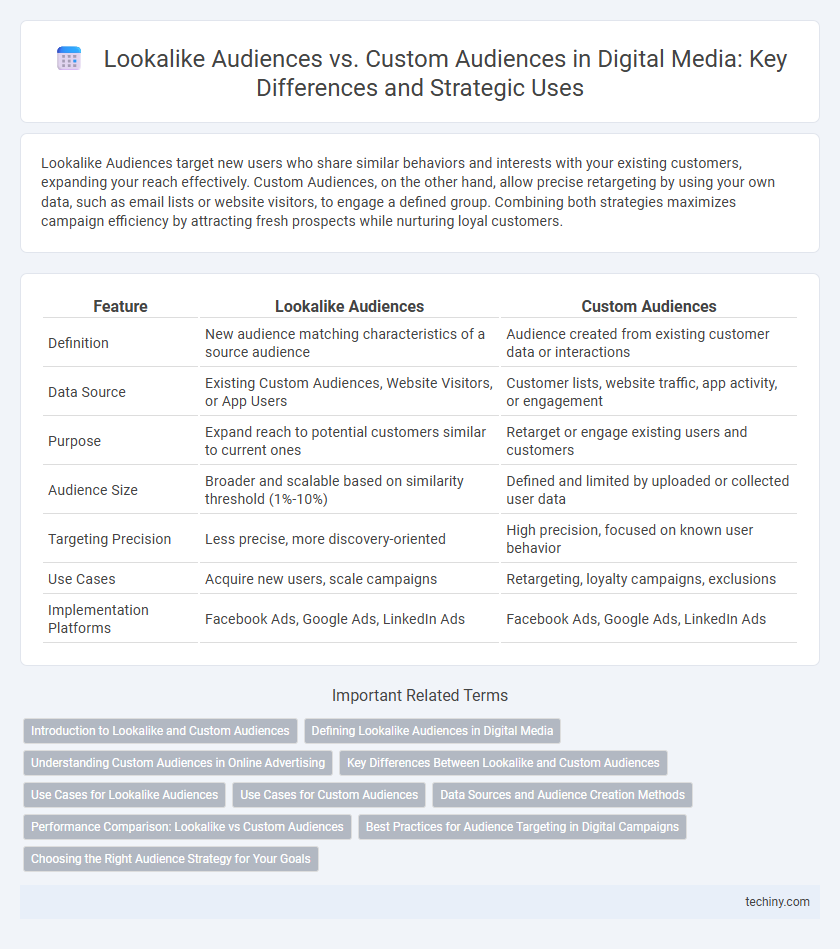Lookalike Audiences target new users who share similar behaviors and interests with your existing customers, expanding your reach effectively. Custom Audiences, on the other hand, allow precise retargeting by using your own data, such as email lists or website visitors, to engage a defined group. Combining both strategies maximizes campaign efficiency by attracting fresh prospects while nurturing loyal customers.
Table of Comparison
| Feature | Lookalike Audiences | Custom Audiences |
|---|---|---|
| Definition | New audience matching characteristics of a source audience | Audience created from existing customer data or interactions |
| Data Source | Existing Custom Audiences, Website Visitors, or App Users | Customer lists, website traffic, app activity, or engagement |
| Purpose | Expand reach to potential customers similar to current ones | Retarget or engage existing users and customers |
| Audience Size | Broader and scalable based on similarity threshold (1%-10%) | Defined and limited by uploaded or collected user data |
| Targeting Precision | Less precise, more discovery-oriented | High precision, focused on known user behavior |
| Use Cases | Acquire new users, scale campaigns | Retargeting, loyalty campaigns, exclusions |
| Implementation Platforms | Facebook Ads, Google Ads, LinkedIn Ads | Facebook Ads, Google Ads, LinkedIn Ads |
Introduction to Lookalike and Custom Audiences
Lookalike Audiences leverage data from Custom Audiences to find new users who share similar behaviors and characteristics, enhancing targeting precision in digital media campaigns. Custom Audiences consist of existing customers or contacts sourced from CRM data, website visitors, or app users, enabling personalized ad delivery based on known user information. Utilizing both audience types allows marketers to efficiently expand reach while maintaining relevance in ad targeting strategies.
Defining Lookalike Audiences in Digital Media
Lookalike Audiences in digital media are defined as targeted groups created by identifying common characteristics and behaviors from a brand's existing Custom Audience, enabling precise expansion of reach to new potential customers who resemble high-value users. This data-driven approach leverages machine learning algorithms to analyze demographics, interests, and online behaviors to optimize ad delivery for better engagement and conversion rates. Marketers use Lookalike Audiences to scale campaigns efficiently while maintaining relevance and maximizing return on ad spend (ROAS).
Understanding Custom Audiences in Online Advertising
Custom Audiences in online advertising allow marketers to target specific groups based on existing customer data, such as email lists, website visitors, or app users, enabling highly personalized ad delivery. This data-driven approach enhances engagement by reaching users who have already interacted with the brand, increasing conversion rates and ROI. Leveraging Custom Audiences helps advertisers refine their campaigns by focusing on individuals most likely to respond, optimizing budget allocation and ad performance.
Key Differences Between Lookalike and Custom Audiences
Lookalike Audiences leverage machine learning algorithms to create new user groups that closely resemble an existing Custom Audience based on shared behaviors and demographics. Custom Audiences consist of directly uploaded user data, such as email lists or website visitors, allowing precise targeting of known customers or leads. The key difference lies in Lookalike Audiences' expansion capabilities versus Custom Audiences' ability to retarget or engage specific existing users with high accuracy.
Use Cases for Lookalike Audiences
Lookalike Audiences are highly effective for expanding reach by targeting new users who share similar behaviors and interests with your existing high-value customers, improving campaign efficiency. They are ideal for acquisition campaigns focused on increasing brand awareness, driving app installs, or boosting sales by leveraging data patterns from Custom Audiences. Marketers use Lookalike Audiences to scale their digital media efforts while maintaining relevance and precision in audience targeting.
Use Cases for Custom Audiences
Custom Audiences enable precise targeting by leveraging existing customer data such as emails, phone numbers, or website interactions, ideal for retargeting campaigns and boosting customer retention. This method excels in re-engaging past customers, increasing conversions through personalized ads tailored to their behavior and preferences. Businesses benefit from Custom Audiences when aiming to nurture loyalty, promote upsells, or recover abandoned carts using highly relevant messaging based on user activity.
Data Sources and Audience Creation Methods
Lookalike Audiences are created using seed data from existing Custom Audiences to identify new users with similar online behaviors and demographics, expanding reach without direct user data input. Custom Audiences rely on first-party data sources such as website visitors, app users, or customer lists to target users who have already interacted with a brand. The key difference lies in data sourcing: Custom Audiences use specific, known user information, while Lookalike Audiences use algorithmic modeling to generate broader, yet relevant, target groups.
Performance Comparison: Lookalike vs Custom Audiences
Lookalike audiences typically drive higher reach and scale by targeting users with similar behaviors to existing customers, often resulting in improved click-through and conversion rates compared to custom audiences. Custom audiences deliver more precise targeting by focusing on existing user data, generally offering higher engagement and conversion efficiency due to tailored messaging. Performance varies by campaign goals; lookalike audiences excel in expanding reach and acquiring new users, while custom audiences optimize for retention and re-engagement.
Best Practices for Audience Targeting in Digital Campaigns
Lookalike Audiences leverage machine learning to find new potential customers who resemble your best existing users, optimizing campaign reach and efficiency. Custom Audiences allow precise retargeting based on specific user interactions or customer data, increasing relevance and conversion rates. Combining both strategies enhances digital campaign performance by expanding reach while maintaining high audience relevance.
Choosing the Right Audience Strategy for Your Goals
Lookalike Audiences leverage existing customer data to target new users with similar behaviors and interests, ideal for expanding reach and acquiring fresh leads. Custom Audiences focus on retargeting existing users who have already interacted with your brand, maximizing conversion rates and customer retention. Selecting the right audience strategy depends on your campaign goal: use Lookalike Audiences to boost brand awareness and Custom Audiences to drive sales and re-engagement.
Lookalike Audiences vs Custom Audiences Infographic

 techiny.com
techiny.com